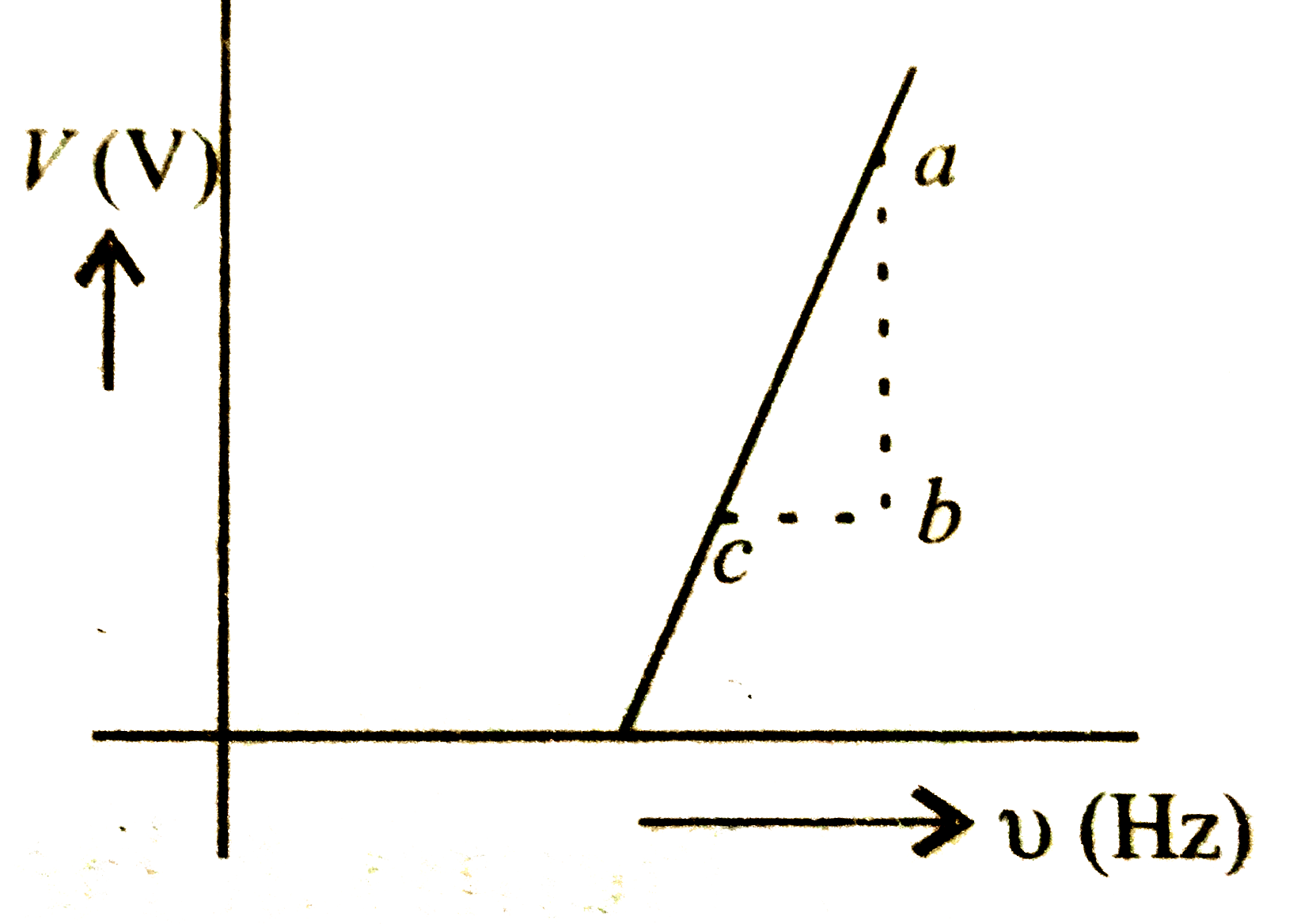Write Einstein’s photoelectric equation. Define the threshold frequency v0 and stopping potential V0.
Step-by-Step Solution
1. Einstein's Photoelectric Equation:
The photoelectric effect describes the emission of electrons from a material when it is exposed to light. Einstein formulated this phenomenon with the following equation:
Ek=hν−hν0
where:
- Ek is the kinetic energy of the emitted electrons.
- h is Planck's constant (6.626×10−34Js).
- ν is the frequency of the incident radiation.
- ν0 is the threshold frequency.
2. Definition of Threshold Frequency (ν0):
The threshold frequency, denoted as ν0, is defined as the minimum frequency of incident radiation required to eject electrons from the surface of a material. If the frequency of the incident light is below this threshold frequency, no photoelectric effect occurs, regardless of the intensity of the light.
3. Definition of Stopping Potential (V0):
The stopping potential, denoted as V0, is defined as the minimum retarding potential needed to stop the emitted photoelectrons from reaching the anode in a photoelectric experiment. At this potential, the photoelectric current becomes zero, indicating that the kinetic energy of the emitted electrons is completely countered by the electric potential.
Summary of Definitions
- Einstein's Photoelectric Equation:
Ek=hν−hν0
- Threshold Frequency (ν0): The minimum frequency of incident radiation below which no photoelectric effect occurs.
- Stopping Potential (V0): The retarding potential at which the photoelectric current becomes zero.
The photoelectric effect describes the emission of electrons from a material when it is exposed to light. Einstein formulated this phenomenon with the following equation:
Ek=hν−hν0
where:
- Ek is the kinetic energy of the emitted electrons.
- h is Planck's constant (6.626×10−34Js).
- ν is the frequency of the incident radiation.
- ν0 is the threshold frequency.
The threshold frequency, denoted as ν0, is defined as the minimum frequency of incident radiation required to eject electrons from the surface of a material. If the frequency of the incident light is below this threshold frequency, no photoelectric effect occurs, regardless of the intensity of the light.
The stopping potential, denoted as V0, is defined as the minimum retarding potential needed to stop the emitted photoelectrons from reaching the anode in a photoelectric experiment. At this potential, the photoelectric current becomes zero, indicating that the kinetic energy of the emitted electrons is completely countered by the electric potential.
- Einstein's Photoelectric Equation:
Ek=hν−hν0
- Threshold Frequency (ν0): The minimum frequency of incident radiation below which no photoelectric effect occurs.
- Stopping Potential (V0): The retarding potential at which the photoelectric current becomes zero.
Topper's Solved these Questions
- BOOK - MBD -HARYANA BOARDCHAPTER - DUAL NATURE OF MATTER AND RADIATIONSEXERCISE - LONG ANSWER TYPE QUESTION1videos
DUAL NATURE OF MATTER AND RADIATIONS
- BOOK - MBD -HARYANA BOARDCHAPTER - DUAL NATURE OF MATTER AND RADIATIONSEXERCISE - OBJECTIVE TYPE QUESTIONS17videos
DUAL NATURE OF MATTER AND RADIATIONS
- BOOK - MBD -HARYANA BOARDCHAPTER - DUAL NATURE OF MATTER AND RADIATIONSEXERCISE - OBJECTIVE TYPE QUESTIONS17videos
DUAL NATURE OF MATTER AND RADIATIONS
- BOOK - MBD -HARYANA BOARDCHAPTER - CURRENT ELECTRICITYEXERCISE - OBJECTIVE TYPE QUESTIONS20videos
CURRENT ELECTRICITY
- BOOK - MBD -HARYANA BOARDCHAPTER - E.M.I. and A.C.EXERCISE - Exercise10videos
E.M.I. and A.C.
Similar Questions
Knowledge Check
- Question 1 - Select One
The stopping potential (V0)
ADepends upon the angle of incident lightBDepends upon the intensity of incident lightCDepends upon the surface nature of the substanceDIs independent of the intensity of the incident light - Question 2 - Select One
In a photoelectric experiment, the graph of frequency v of incident light (in Hz) and stopping potential V (in V) is as shown in the figure. Planck's constant is (e is the elementary charge)
 AeabbcBecbacCeacbcDeacab
AeabbcBecbacCeacbcDeacab - Question 3 - Select One
The emission of electrons from a metal surface exposed rto light radaition of appropriate wavelength is called photoelectroic effect .The emmited electron are called photo=-weklectron work function of threshold energy may be defined as the minimum amount of energy required to ejercted electron from a most surface .According to Einstein
Maximum kinetic energy of ejected electron = Aborbed energy - Work function
12mv2max=h(v)−h(vn)=hv[1λ−1λn]
Where vn and λ0 are thereshold frequency and threshold wavelength respectively
Sopping potential : it is the miximum potential at which the photoelectric current becomes zero if V0 is the stopping potential eV0=h(v−v0)
In the photoelectric currect effect the shape of strainght line graph between stopping potential (V0) and frequency of incident light (V) gves
 Acharge on electronBwork function of emitterCplak's constantDratio of plank's constyant to charge on electron
Acharge on electronBwork function of emitterCplak's constantDratio of plank's constyant to charge on electron
State Einstein’s photoelectric equation and explain the terms involved.
View Solution(a) State three important properties of photons which describe the particle picture of electromagnetic radiation.
(b) Use Einstein's photoelectric equation to define the terms (i) stopping potential and (ii) threshold frequency.View SolutionWrite Einstein’s photoelectric equation. State Clearly the three salient features observed in photoelectric effect which can be explained on the basis of the above equation
View SolutionUsing Einstein's photoelectric equation show how the cut -off voltage and threshold frequency for a given photosenstive material can be determined with the help of a suitable plot/graph.
View SolutionDefine the term 'threshold frequency' in photoelectric emission.
View Solution

